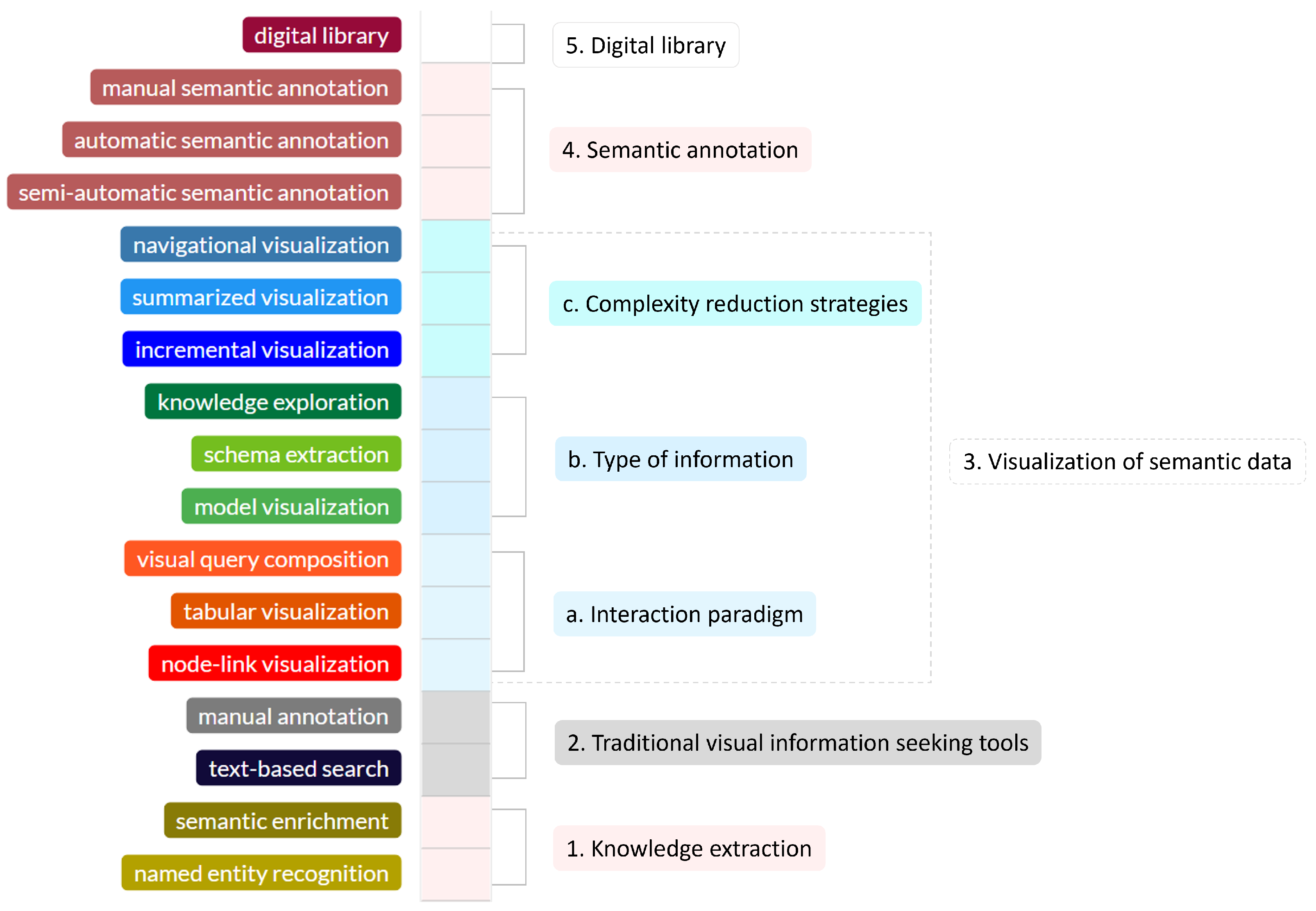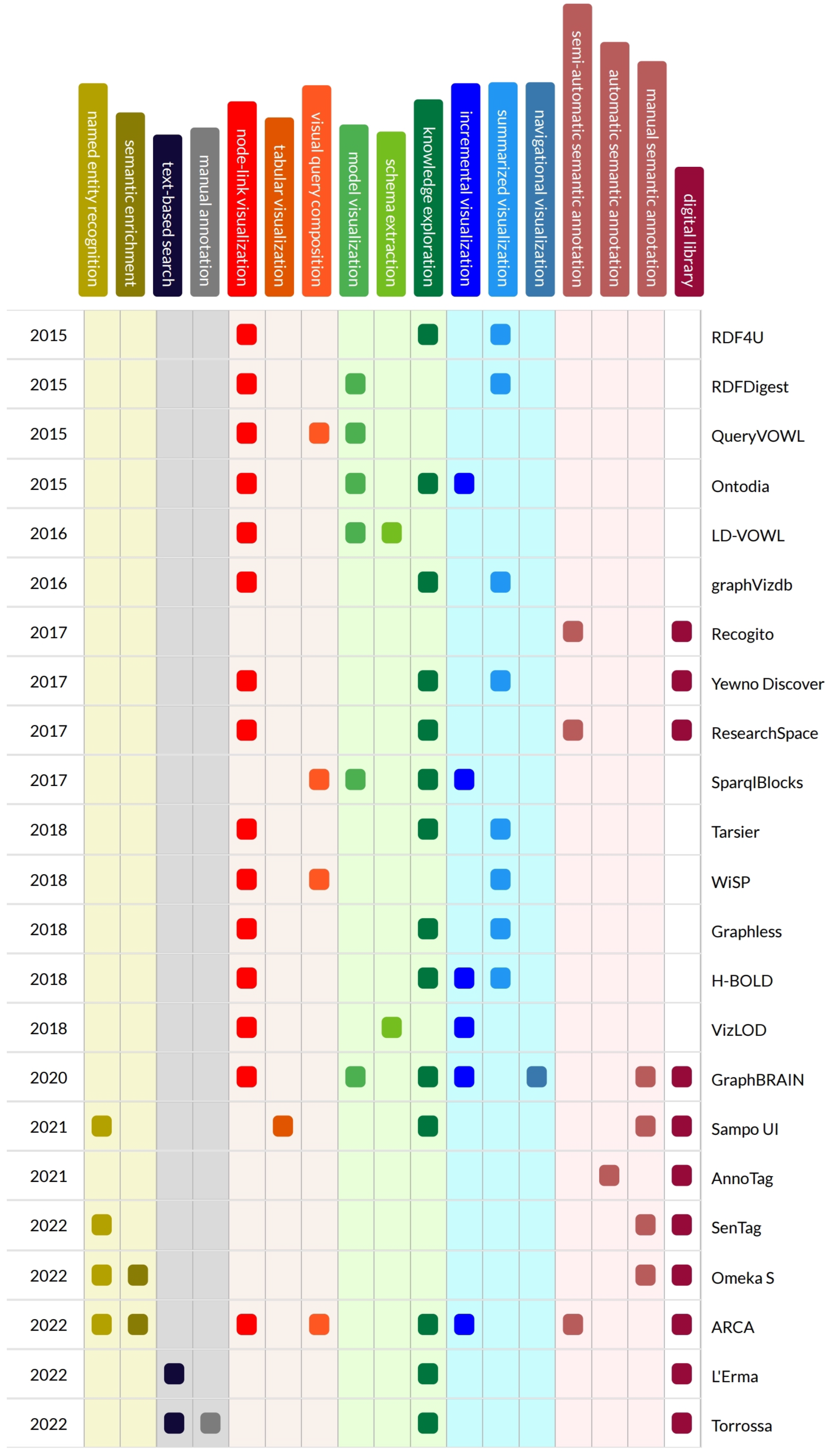You're using an outdated browser. Please upgrade to a modern browser for the best experience.
Please note this is a comparison between Version 2 by Rita Xu and Version 3 by Rita Xu.
In the era of big data, linked data interfaces play a critical role in enabling access to and management of large-scale, heterogeneous datasets. This suresearchvey investigates forty-seven interfaces developed by the semantic web community in the context of the Web of Linked Data, displaying information about general topics and digital library contents. The interfaces are classified based on their interaction paradigm, the type of information they display, and the complexity reduction strategies they employ. The main purpose to be addressed is the possibility of categorizing a great number of available tools so that comparison among them becomes feasible and valuable. The analysis reveals that most interfaces use a hybrid interaction paradigm combining browsing, searching, and displaying information in lists or tables. Complexity reduction strategies, such as faceted search and summary visualization, are also identified. Emerging trends in linked data interface focus on user-centric design and advancements in semantic annotation methods, leveraging machine learning techniques for data enrichment and retrieval. Additionally, an interactive platform is provided to explore and compare data on the analyzed tools. Overall, there is no one-size-fits-all solution for developing linked data interfaces and tailoring the interaction paradigm and complexity reduction strategies to specific user needs is essential.
- linked data interfaces
- semantic web
- web of linked data
1. Introduction
The landscape of Linked Data and the semantic web has extended its influence across diverse disciplines, revolutionizing how researchers handle and comprehend data [1]. From academia to industry, from healthcare to entertainment, the principles of Linked Data and the semantic web have transcended traditional boundaries, offering a unifying framework for organizing and leveraging data. In light of this transformative impact, this research seeks to comprehensively examine the landscape of tools and interfaces developed within the context of Linked Data and the semantic web. Researchers recognize that despite the remarkable advancements, there exists a need for a structured overview of the available tools, along with an exploration of their characteristics, functionalities, and evolving trends. By addressing these gaps, the aim is to provide a valuable resource for researchers, practitioners, and enthusiasts navigating the intricate realm of Linked Data interfaces.
The primary objective of this research is to categorize and analyze a spectrum of Linked Data interfaces, elucidating their features and purposes. Researchers delve into tools catering to semantic data management, traditional visual information seeking, semantic data visualization, collaborative annotation, and digital libraries. This comprehensive categorization allows researchers to pinpoint the strengths and limitations of existing tools and identify the emerging trends in the field. To accomplish this goal, researchers first identify five recurring macro-characteristics that encompass a diverse range of Linked Data interfaces:
Knowledge Extraction: Tools aimed at extracting knowledge from unstructured data.
Traditional Visual Information Seeking Tools: Conventional systems for seeking information through visual representations.
Visualization of Semantic Data: Tools for displaying retrieving and representing semantic data.
Semantic Annotation: Tools for collaboratively annotating semantic data.
Digital Library: Specific tools for the management and exploration of a collection of books.

Figure 1. Classification categories.
In Figure 1, researchers present these macro-classification categories along with their respective sub-categories, offering readers a visual roadmap of the entry’s structure. Subsequently, for each category, researchers conduct targeted searches to identify relevant tools, dissect their characteristics, and evaluate their impact. Researchers then delve into dedicated sections where they describe and analyze the identified categories, presenting the representative tools researchers consider instrumental within each classification.
Researchers embark on this journey through Linked Data interfaces, exploring their functionalities, strengths, and areas for improvement. By uncovering the trends and patterns within these tools, the aim is to contribute to a deeper understanding of the evolving landscape of Linked Data interfaces.
Researchers select forty-seven tools that are most representative of their respective categories as a practical example. The tools are listed in Figure 2 and Figure 3 with the categories to which they belong assigned.

Figure 2. Semantic web tools-first part.

Figure 3. Semantic web tools-second part.
While the research and literature provide researchers with a complete overview of methodologies, algorithms, and advantages, there exists a full list of domains of application that have taken advantage of the benefits of Linked Data Interfaces. Historically, one of the main uses of Linked Data was to support Natural Language Processing (NLP) tasks such as injecting ontologies or dictionaries into concepts expressed in natural language [2], expanding the knowledge of a domain by adding contextual information [3] or introducing explainability in recommendation tasks [4]. Closely related to natural language processing tasks, the field of Digital Libraries exploits the effectiveness and volume of Linked Data for tasks such as cataloguing, visualizing, and recommending resources [5]. Taking everything into account, researchers see opportunities for Linked Data Interfaces wherever there is a need to complete, integrate and connect (possibly heterogeneous) resources.
2. Conclusions and Emerging Trends
Linked Data interfaces are constantly evolving, and several emerging trends are shaping their development. These trends are driven by technological advancements, changing user needs, and the increasing adoption of Semantic Web technologies. Throughout this survey of Linked Data interfaces, researchers have explored various categories of tools and discovered how they facilitate intelligent and intuitive exploration and querying of LD.
One prominent emerging trend is the integration of Artificial Intelligence (AI) and machine learning techniques into Linked Data interfaces. These AI algorithms enable automated semantic annotation, entity recognition, and knowledge extraction from unstructured content. Through these intelligent interactions, users can benefit from personalized recommendations, context-aware search results, and adaptive visualizations.
Another critical aspect is the understanding and interpretation of the insights generated by AI algorithms, which are being facilitated by the introduction of explainable AI. This feature is crucial in building trust in the system and ensuring the accuracy and reliability of the results.
Linked Data interfaces are increasingly embracing NLP, enabling users to interact with Linked Data resources using everyday language, breaking down access barriers and expanding the user base.
The adoption of emerging technologies such as Augmented Reality (AR) and Virtual Reality (VR) is redefining the exploration of LD, allowing users to interact with complex knowledge graphs in immersive 3D spaces.
Another important trend is the adoption of multimodal interfaces, combining different modes of interaction such as text, images, voice, and gestures. These interfaces respond to the preferences and needs of diverse users, offering a more inclusive and engaging experience.
Finally, the entire dataset collected during the analysis of the presented Linked Data interfaces in this survey is available on the website: https://linkeddata-89b9d.web.app (accessed on 28 August 2023). This website offers users the opportunity to iteratively explore and compare the various tools discussed in the survey, enabling them to experience and understand the different functionalities and approaches implemented by each tool. This online resource serves as a valuable reference point for in-depth knowledge of Linked Data interfaces and facilitates access and evaluation of the various available tools. Through this initiative, greater transparency and information sharing are promoted, encouraging collaboration and progress in the field of Linked Data interfaces.
References
- Damljanovic, D.; Agatonovic, M.; Cunningham, H. FREyA: An interactive way of querying Linked Data using natural language. In Proceedings of the The Semantic Web: ESWC 2011 Workshops: ESWC 2011 Workshops, Heraklion, Greece, 29–30 May 2011; Revised Selected Papers 8. Springer: Berlin/Heidelberg, Germnay, 2012; pp. 125–138.
- Skevakis, G.; Makris, K.; Kalokyri, V.; Arapi, P.; Christodoulakis, S. Metadata management, interoperability and Linked Data publishing support for Natural History Museums. Int. J. Digit. Libr. 2014, 14, 127–140.
- Dietze, S.; Drachsler, H.; Giordano, D. A survey on linked data and the social web as facilitators for TEL recommender systems. Recomm. Syst. Technol. Enhanc. Learn. Res. Trends Appl. 2014, 1, 47–75.
- Raza, Z.; Mahmood, K.; Warraich, N.F. Application of linked data technologies in digital libraries: A review of literature. Library Hi Tech News 2019, 36, 9–12.
- Hoffart, J.; Yosef, M.; Bordino, I.; Fürstenau, H.; Pinkal, M.; Spaniol, M.; Taneva, B.; Thater, S.; Weikum, G. Robust disambiguation of named entities in text. In Proceedings of the 2011 Conference on Empirical Methods in Natural Language Processing, Edinburgh, UK, 27–31 July 2011; pp. 782–792.
More
